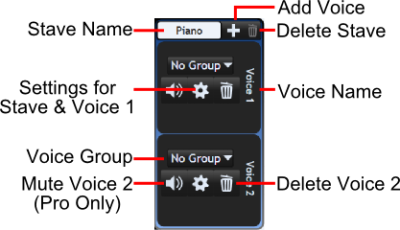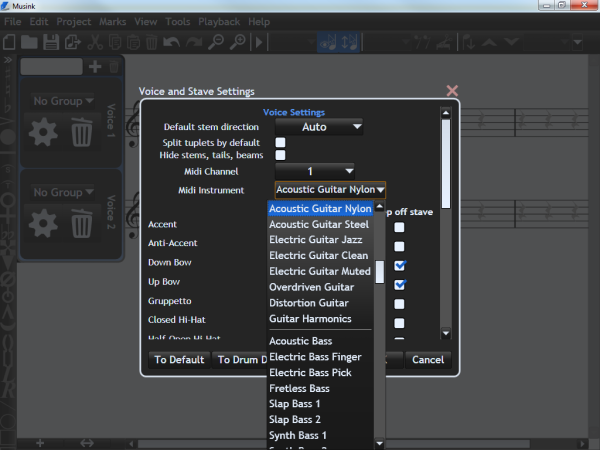MIDI Instruments (Programs)
Musink plays back scores through external MIDI devices installed on your computer. How an stave sounds in Musink is dependent on both the device connected, and the instrument selected in Musink.
Terminology
In this context an instrument defines how music sounds (e.g. like a piano); it does not refer to a physical instrument you can plug into your computer. In MIDI terminology instruments are referred to as programs or program numbers.
Setting Instruments
There are two ways to set the playback instrument in Musink: during project/section creation, and with voice settings.
Video Demonstration
Project Creation
When creating a new project or section, write the name of the instrument in the box provided. If this is a recognised instrument, Musink will set the MIDI instrument automatically.
Voice Settings
To change the instrument of individual voices once a project has been created:
1. Ensure that voice editors are expanded. If they are not, click them to expand them.
2. Click on the settings button to open voice and stave settings
3. Click the drop-down menu marked MIDI Instrument
4. Select the instrument you wish to use
5. Click OK
Available Instruments
Musink supports all instruments specified by the General Midi protocol. Some MIDI devices that Musink can connect to, such as Microsoft GS Wavetable Synth, support all instruments in the MIDI protocol. Other MIDI devices may not.
The following instruments are available:
| Instrument | MIDI Program Number* | Notes |
|---|---|---|
| Special | ||
| No Instrument | N/A | Midi Instrument information is not sent |
| Percussion | N/A | Switches voice to Channel 10. Midi Instrument information is not sent |
| Pianos | ||
| Acoustic Grand Piano | 1 | |
| Bright Acoustic Piano | 2 | |
| Electric Grand Piano | 3 | |
| Honky Tonk Piano | 4 | |
| Electric Piano 1 | 5 | |
| Electric Piano 2 | 6 | |
| Harpsichord | 7 | |
| Clavinet | 8 | |
| Chromatic Percussion | ||
| Celesta | 9 | |
| Glockenspiel | 10 | |
| Music Box | 11 | |
| Vibraphone | 12 | |
| Marimba | 13 | |
| Xylophone | 14 | |
| Tubular Bells | 15 | |
| Timpani | 48 | Normally falls under strings category according to GM standard |
| Organ | ||
| Dulcimer | 16 | |
| Drawbar Organ | 17 | |
| Percussive Organ | 18 | |
| Rock Organ | 19 | |
| Church Organ | 20 | |
| Reed Organ | 21 | |
| Accordion | 22 | |
| Harmonica | 23 | |
| Tango Accordion | 24 | |
| Guitar | ||
| Acoustic Guitar Nylon | 25 | |
| Acoustic Guitar Steel | 26 | |
| Electric Guitar Jazz | 27 | |
| Electric Guitar Clean | 28 | |
| Electric Guitar Muted | 29 | |
| Overdriven Guitar | 30 | |
| Distortion Guitar | 31 | |
| Guitar Harmonics | 32 | |
| Bass | ||
| Acoustic Bass | 33 | |
| Electric Bass Finger | 34 | |
| Electric Bass Pick | 35 | |
| Fretless Bass | 36 | |
| Slap Bass 1 | 37 | |
| Slap Bass 2 | 38 | |
| Synth Bass 1 | 39 | |
| Synth Bass 2 | 40 | |
| Strings | ||
| Violin | 41 | |
| Viola | 42 | |
| Cello | 43 | |
| Contrabass | 44 | |
| Tremolo Strings | 45 | |
| Pizzicato Strings | 46 | |
| Orchestral Harp | 47 | |
| Ensemble | ||
| String Ensemble 1 | 49 | |
| String Ensemble 2 | 50 | |
| Synth Strings 1 | 51 | |
| Synth Strings 2 | 52 | |
| Choir Aahs | 53 | |
| Voice Oohs | 54 | |
| Synth Voice | 55 | |
| Orchestra Hit | 56 | |
| Brass | ||
| Trumpet | 57 | |
| Trombone | 58 | |
| Tuba | 59 | |
| Muted Trumpet | 60 | |
| French Horn | 61 | |
| Brass Section | 62 | |
| Synth Brass 1 | 63 | |
| Synth Brass 2 | 64 | |
| Reed | ||
| Soprano Sax | 65 | |
| Alto Sax | 66 | |
| Tenor Sax | 67 | |
| Baritone Sax | 68 | |
| Oboe | 69 | |
| English Horn | 70 | |
| Bassoon | 71 | |
| Clarinet | 72 | |
| Pipe | ||
| Piccolo | 73 | |
| Flute | 74 | |
| Recorder | 75 | |
| Pan Flute | 76 | |
| Blown Bottle | 77 | |
| Shakuhachi | 78 | |
| Whistle | 79 | |
| Ocarina | 80 | |
| Synth Lead | ||
| Lead 1: Square | 81 | |
| Lead 2: Sawtooth | 82 | |
| Lead 3: Calliope | 83 | |
| Lead 4: Chiff | 84 | |
| Lead 5: Charang | 85 | |
| Lead 6: Voice | 86 | |
| Lead 7: Fifths | 87 | |
| Lead 8: Bass And Lead | 88 | |
| Synth Pad | ||
| Pad 1: New Age | 89 | |
| Pad 2: Warm | 90 | |
| Pad 3: Polysynth | 91 | |
| Pad 4: Choir | 92 | |
| Pad 5: Bowed | 93 | |
| Pad 6: Metallic | 94 | |
| Pad 7: Halo | 95 | |
| Pad 8: Sweep | 96 | |
| Synth Effects | ||
| Fx 1: Rain | 97 | |
| Fx 2: Soundtrack | 98 | |
| Fx 3: Crystal | 99 | |
| Fx 4: Atmosphere | 100 | |
| Fx 5: Brightness | 101 | |
| Fx 6: Goblins | 102 | |
| Fx 7: Echoes | 103 | |
| Fx 8: Sci Fi | 104 | |
| Ethnic | ||
| Sitar | 105 | |
| Banjo | 106 | |
| Shamisen | 107 | |
| Koto | 108 | |
| Kalimba | 109 | |
| Bag Pipe | 110 | |
| Fiddle | 111 | |
| Shanai | 112 | |
| Percussive | ||
| Tinkle Bell | 113 | |
| Agogo | 114 | |
| Steel Drums | 115 | |
| Woodblock | 116 | |
| Taiko Drum | 117 | |
| Melodic Tom | 118 | |
| Synth Drum | 119 | |
| Sound Effects | ||
| Reverse Cymbal | 120 | |
| Guitar Fret Noise | 121 | |
| Breath Noise | 122 | |
| Seashore | 123 | |
| Bird Tweet | 124 | |
| Telephone Ring | 125 | |
| Helicopter | 126 | |
| Applause | 127 | |
| Gunshot | 128 |
*Program numbers here are 1-indexed.

